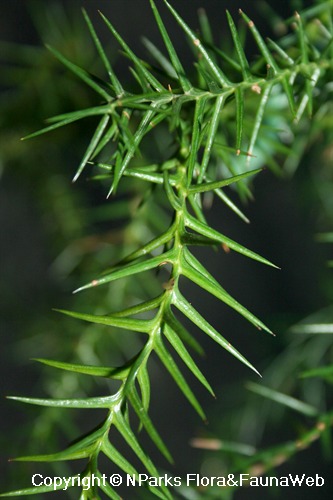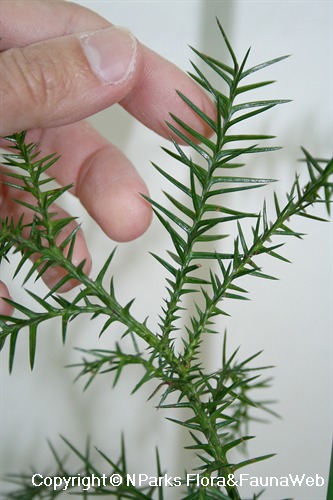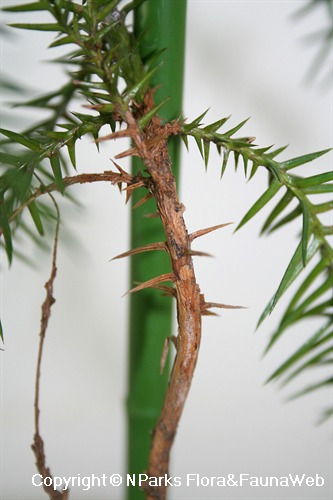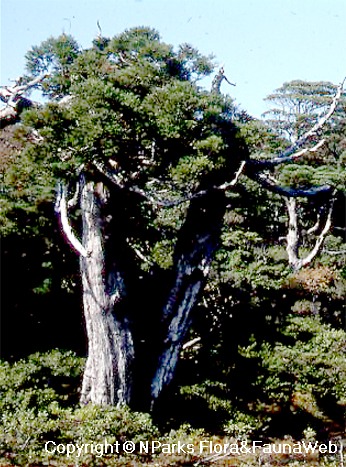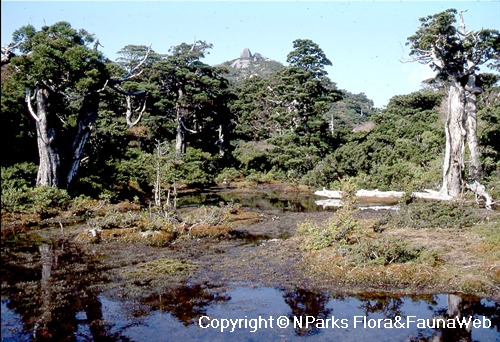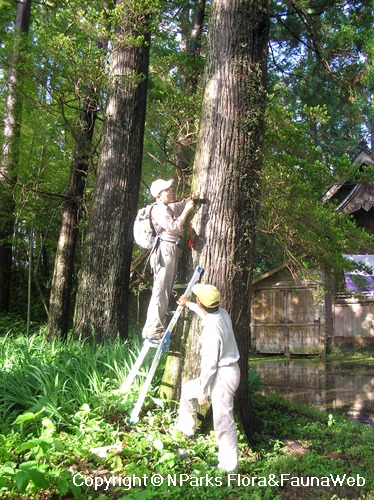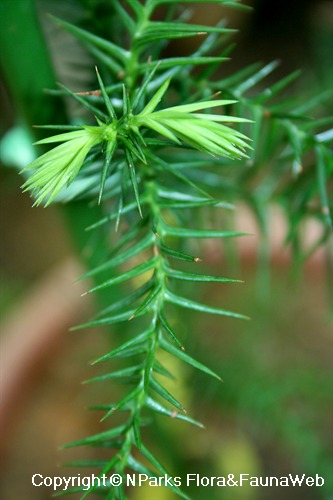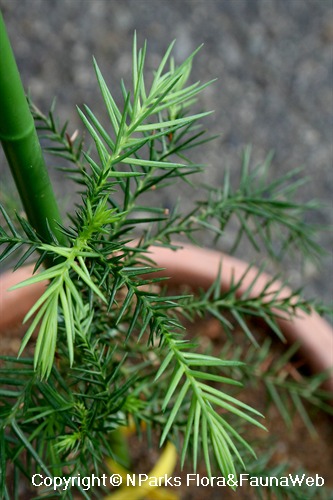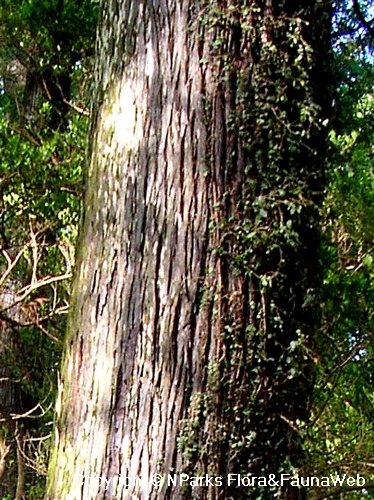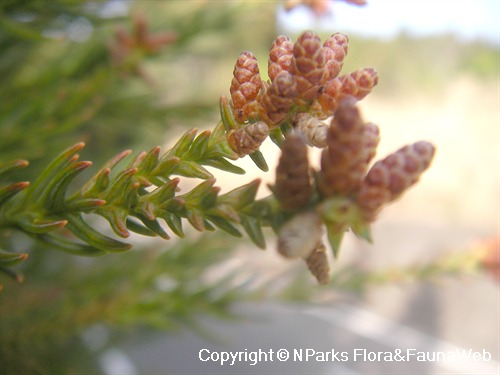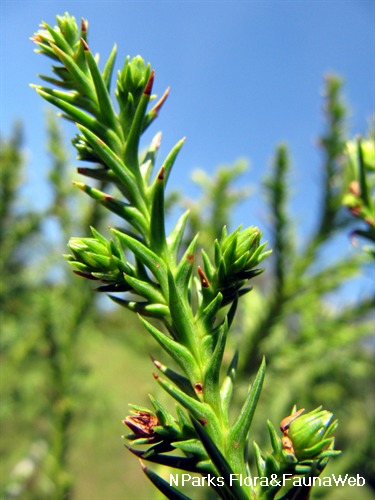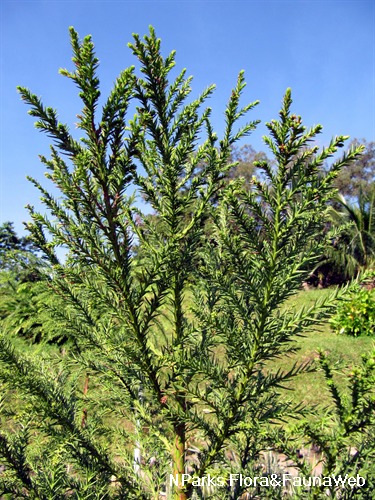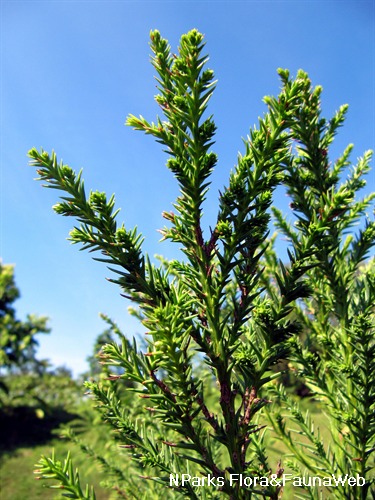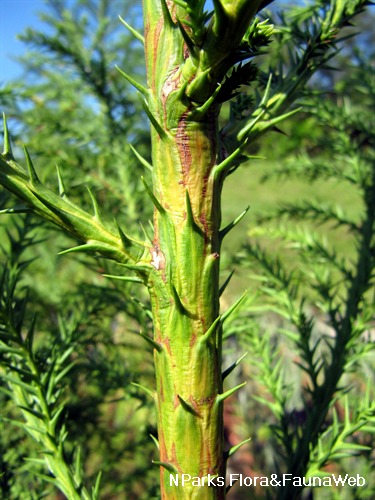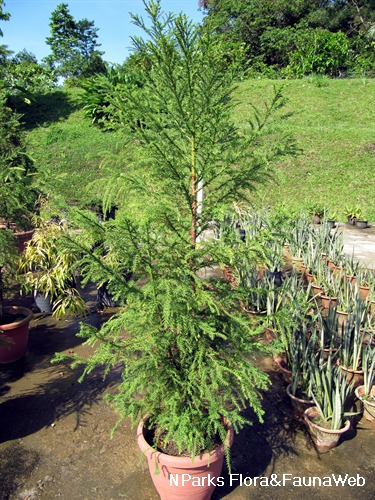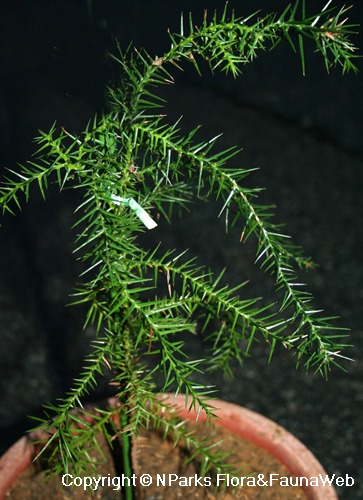
Back
Cryptomeria japonica (L. f.) D. Don
| Family Name: | Taxodiaceae |
| Synonyms: | Cryptomeria japonica f. compacta, Cryptomeria japonica f. spiralis, Cryptomeria japonica f. araucarioides |
| Common Name: | Japanese Cedar, Sugi, Japanese Redwood, 日本柳杉, 柏科 |
Name
Classifications and Characteristics
| Plant Division | Gymnosperms (Non-Flowering Seed Plants) (Conifer) |
|---|---|
| Plant Growth Form | Tree (Big (>30m), Medium (16m-30m)) |
| Lifespan (in Singapore) | Perennial |
| Mode of Nutrition | Autotrophic |
| Plant Shape | Conical |
| Maximum Height | 15 m to 50 m |
Biogeography
| Native Distribution | Japan, long naturalized in southern China |
|---|---|
| Native Habitat | Terrestrial (Temperate Forest, Mountain) |
| Preferred Climate Zone | Temperate |
Description and Ethnobotany
| Foliage | Leaves green, flattened and needle-like, stiif and prickly, spiral densely around twigs in ranks of 5, subsequent leaves longer than earlier-produced leaves, persist on tree for 4-5 years. Young flush bright light green. |
|---|---|
| Others - Plant Morphology | Growth Form: Medium to large coniferous tree, up to 50m height in native habitat, but typically 15 - 25m tall and 6m wide under cultivation. Ancient family lineage, existing since time of dinosaurs. rown shape varies with age -- young trees conical, middle-aged trees billowly pyramidal, old trees have more open and irregular crowns. Branches whorled, with pendulous branchelets, usually persistent on tree, and old specimens may have branches touching the ground. Bark: Trunk's bark reddish-brown to grey, fibrous, peeling in long strips, somewhat attractive. Juvenile vs. Adult Foliage: Juvenile and adult leaves assume different arrangements -- adult leaves produced when tree reaches one year of age, borne at smaller angles to twig axis, resulting in closely overlapping appearance, while juvenile leaves are more perpendicular to twig axis. In temperate regions, leaves turn bronzy in autumn and winter in reaction to cold, before reverting to green in spring.Reproductive Cones: Non-flowering monoecious plant -- flowers and fruits are naked cones instead, with separate male and female cones found on same tree. Male (pollen) cones ellipsoidal, produced in terminal clusters of 6-25, mature from green to brown. Female cones globuse, subtended by scales, produced in clusters of 1-6, ripen from green to brown in first year and persist on tree for another 1-2 years, before opening up and releasing the seeds. |
| Associated Fauna | Host plant for larvae of some types of Endoclita moths. |
| Cultivation | Slow-growing with lifespan of more than 650 years. Prefers deep, well-drained soils rich in organic matter, pH 3.7 to 6.0. Tolerant of saline soils. Established plants are drought-tolerant, but never let soil dry out for young growing plants. Avoid placing plants in low-humidity areas (eg. aircon rooms) for prolonged periods due to tendency of leaf shed under such conditions. Propagation by softwood cuttings (slow to root) and simple layering preferred over seeds (slow and unreliable germination). Keep foliage dry to prevent fungal diseases, which cause leaf spots or browning. |
| Etymology | Despite its misleading common name 'Japanese Cedar', plant is not related to true cedars (Cedrus species). Genus epithet 'Cryptomeria' means 'hidden part', referring to seeds being concealed within the bracts of female cones. |
| Ethnobotanical Uses | Others: Timber: Popular economic timber tree in Japan and Hawaii, grown in plantations for reddish-pink scented heartwood that is strong and rot-resistant, often used for buildings, bridges, ships, posts, furniture, utensils and making paper. Also used for making collector items like ornamental pens. Cultural: National tree of Japan, widely cultivated since 1300 AD, revered for its beauty and commonly planted around temples. |
Landscaping Features
| Desirable Plant Features | Ornamental Foliage, Fragrant (Flowers) (Time Independent), Ornamental Trunk |
|---|---|
| Landscape Uses | Container Planting, Suitable for Bonsai, Suitable for Roadsides, Coastal, General, Hedge / Screening |
| Usage Hazard - Cons | Spines/Thorns - Leaf, Irritant - Nasal Allergy |
| Usage Hazard - Cons Remarks | Leaves are stiff and prickly, may cause skin irritation. Pollen is a major cause of hayfever in Japan. |
| Plant & Rootzone Preference or Tolerance Remarks | Tolerates soil pH 3.7 - 6.0. |
Fauna, Pollination and Dispersal
| Pollination Method(s) | Abiotic (Wind) |
|---|---|
| Seed or Spore Dispersal | Abiotic (Explosive Dehiscence) |
Plant Care and Propagation
| Light Preference | Full Sun |
|---|---|
| Water Preference | Moderate Water |
| Plant Growth Rate | Slow |
| Rootzone Tolerance | Fertile Loamy Soils, Well-Drained Soils, Saline Soils / Salt Spray, Acidic (low pH) Soils, Drought Tolerant |
| Maintenance Requirements | Moderate |
| Diseases | Mites & scales on foliage. Leaf spots & leaf blight -- which causes browning of interior foliage. For prevention, keep leaves as dry as possible, provide good air circulation, or treat with fungicide spray. |
| Pest(s) | Associated with, Sucking Insects |
| Propagation Method | Seed, Stem Cutting, Air-Layering |
| Propagule Establishment Remarks | Seed germination slow and unreliable, better success rates if germinated under light. Softwood cuttings preferred, although rooting is slow. |
Foliar
| Foliage Retention | Evergreen |
|---|---|
| Mature Foliage Colour(s) | Green |
| Mature Foliage Texture(s) | Smooth, Thick |
| Foliar Modification | Reduced / Needle-like |
| Foliar Type | Simple / Unifoliate |
| Foliar Arrangement Along Stem | Whorled, Spiral |
| Foliar Shape(s) | Non-Palm Foliage (Lanceolate) |
| Foliar Venation | Parallel |
| Foliar Margin | Entire |
| Foliar Apex - Tip | Acuminate |
| Foliar Base | Truncate / Square |
| Typical Foliar Area | Nanophyll ( 0.25cm2 - 2.25 cm2 ) |
| Leaf Area Index (LAI) for Green Plot Ratio | 3.0 (Tree - Intermediate Canopy) |
Non - Foliar and Storage
| Trunk Type (Non Palm) | Woody |
|---|---|
| Bark Colour(s) | Reddish-brown, dark grey |
| Mature Bark Texture | Fissured, Peeling / Flaking / Papery |
| Stem Type & Modification | Woody |
| Root Type | Underground (Tap Root, Fibrous Root) |
| Mature Bark Texture Remarks | Bark peels in long vertical strips |
Floral (Angiosperm)
| Flower & Plant Sexuality | Unisexual Flowers , Monoecious |
| Flowering Habit | Polycarpic |
|---|
Fruit, Seed and Spore
| Mature Fruit Colour(s) | Brown |
|---|---|
| Fruit Classification | Simple Fruit |
| Fruit Type | Indehiscent Dry Fruit |
Image Repository
Others
| Master ID | 8311 |
|---|---|
| Species ID | 3317 |
| Flora Disclaimer | The information in this website has been compiled from reliable sources, such as reference works on medicinal plants. It is not a substitute for medical advice or treatment and NParks does not purport to provide any medical advice. Readers should always consult his/her physician before using or consuming a plant for medicinal purposes. |

